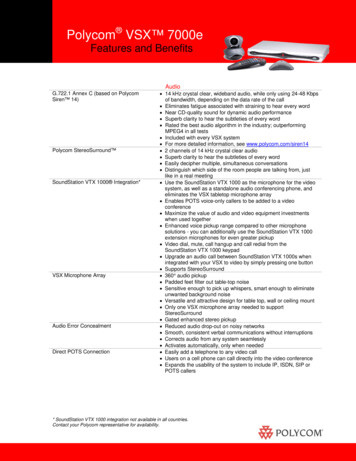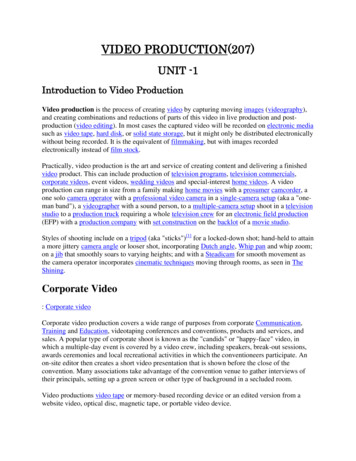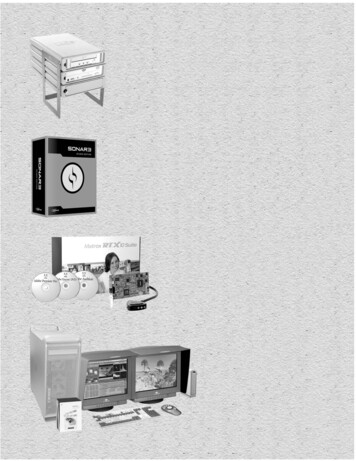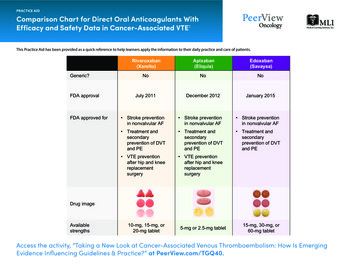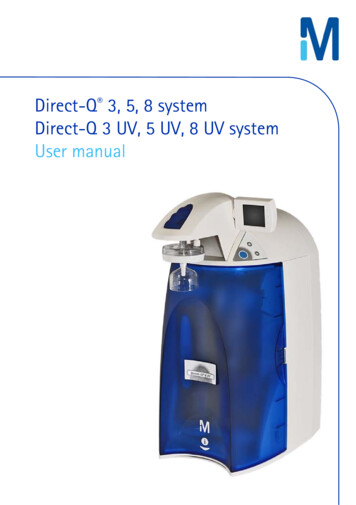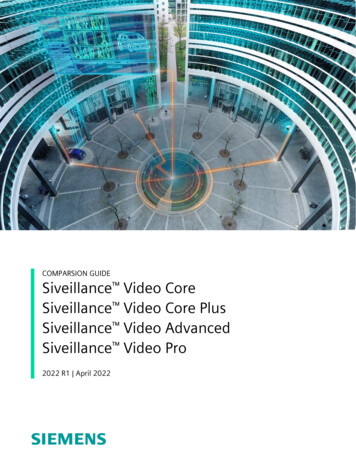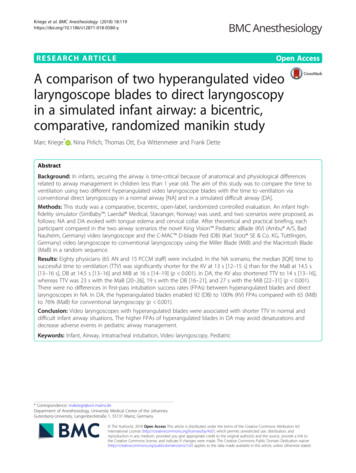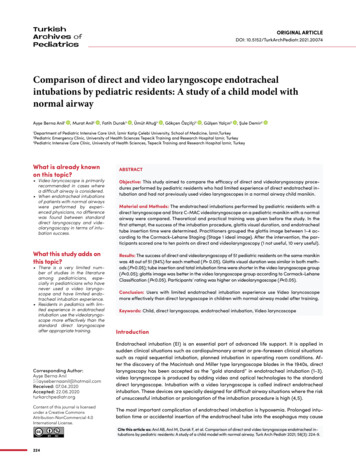
Transcription
TurkishArchives ofORIGINAL ARTICLEDOI: ison of direct and video laryngoscope endotrachealintubations by pediatric residents: A study of a child model withnormal airwayAyşe Berna Anil1, Murat Anil2, Fatih Durak3, Ümüt Altuğ3, Gökçen Özçifçi3, Gülşen Yalçın2, Şule Demir2Department of Pediatric Intensive Care Unit, İzmir Katip Çelebi University, School of Medicine, İzmir,TurkeyPediatric Emergency Clinic, University of Health Sciences Tepecik Training and Research Hospital Izmir, Turkey3Pediatric Intensive Care Clinic, University of Health Sciences, Tepecik Training and Research Hospital İzmir, Turkey12What is already knownon this topic? Video laryncoscope is primarilyrecommended in cases wherea difficult airway is considered. When endotracheal intubationsof patients with normal airwayswere performed by experienced physicians, no differencewas found between standarddirect laryngoscopy and videolaryngoscopy in terms of intubation success.What this study adds onthis topic?ABSTRACTObjective: This study aimed to compare the efficacy of direct and videolaryngoscopy procedures performed by pediatric residents who had limited experience of direct endotracheal intubation and had not previously used video laryngoscopes in a normal airway child manikin.Material and Methods: The endotracheal intubations performed by pediatric residents with adirect laryngoscope and Storz C-MAC videolaryngoscope on a pediatric manikin with a normalairway were compared. Theoretical and practical training was given before the study. In thefirst attempt, the success of the intubation procedure, glottis visual duration, and endotrachealtube insertion time were determined. Practitioners grouped the glottis image between 1-4 according to the Cormack-Lehane Staging (Stage 1 ideal image). After the intervention, the participants scored one to ten points on direct and videolaryngoscopy (1 not useful, 10 very useful).Results: The success of direct and videolaryngoscopy of 51 pediatric residents on the same manikinwas 48 out of 51 (94%) for each method (P 0.05). Glottis visual duration was similar in both methods (P 0.05); tube insertion and total intubation time were shorter in the video laryngoscope group(P 0.05); glottis image was better in the video laryngoscope group according to Cormack-LehaneClassification (P 0.05). Participants’ rating was higher on videolaryngoscope (P 0.05). There is a very limited number of studies in the literatureamong pediatricians, especially in pediatricians who havenever used a video laryngoscope and have limited endotracheal intubation experience. Residents in pediatrics with limited experience in endotrachealintubation use the videolaryngoscope more effectively than thestandard direct laryngoscopeafter appropriate training.IntroductionCorresponding Author:Ayşe Berna Anıl aysebernaanil@hotmail.comReceived: 07.04.2020Accepted: 22.06.2020turkarchpediatr.orgEndotracheal intubation (EI) is an essential part of advanced life support. It is applied insudden clinical situations such as cardiopulmonary arrest or pre-foreseen clinical situationssuch as rapid sequential intubation, planned intubation in operating room conditions. After the discovery of the Macintosh and Miller type laryngoscope blades in the 1940s, directlaryngoscopy has been accepted as the “gold standard” in endotracheal intubation (1-3).video laryngoscope is produced by adding video and optical technologies to the standarddirect laryngoscope. Intubation with a video laryngoscope is called indirect endotrachealintubation. These devices are specially designed for difficult airway situations where the riskof unsuccessful intubation or prolongation of the intubation procedure is high (4,5).Content of this journal is licensedunder a Creative CommonsAttribution-NonCommercial 4.0International License.Conclusion: Users with limited endotracheal intubation experience use Video laryncoscopemore effectively than direct laryngoscope in children with normal airway model after training.Keywords: Child, direct laryngoscope, endotracheal intubation, Video laryncoscopeThe most important complication of endotracheal intubation is hypoxemia. Prolonged intubation time or accidental insertion of the endotracheal tube into the esophagus may causeCite this article as: Anıl AB, Anıl M, Durak F, et al. Comparison of direct and video laryngoscope endotracheal intubations by pediatric residents: A study of a child model with normal airway. Turk Arch Pediatr 2021; 56(3): 224-9.224
Turk Arch Pediatr 2021; 56(3): 224-9ischemic brain damage due to hypoxemia (6,7). The effectiveness and success of video laryngoscopy in reducing complications in children with normal airways is controversial. Clinicaltrials have often been conducted under pediatric anestheticconditions (5,8).We hypothesize that in children with normal airways, the video laryngoscope is more effective than the standard direct laryngoscope in the hands of users with limited experience. Thisstudy, after theoretical and practical training, it was aimed tocompare the effectiveness of standard direct laryngoscopyand video laryngoscopy procedures performed by residents inpediatrics who had never used a video laryngoscope before ina pediatric manikin with the normal airway.Materials and MethodsThe study was conducted in the Izmir Tepecik Training and Research Hospital, Department of Pediatrics. Residents in pediatrics were included in the study voluntarily. Those who did notwant to participate in the study and those with health problemsduring the study were excluded from the study.Anıl et al. Direct and video laryngoscope in child manikinA standard training model simulating the head of a 5-year-oldchild head size (Life/form Child Airway Management Trainerwith Stand, Product Code: LF03609, Nasco-Simulaids, Wisconsin, USA) was used for the endotracheal intubation procedure.Two different ways were compared in intubation: 1. Directlaryngoscopy (standard laryngoscope handle, Macintosh 2curved blade, plusMED, Istanbul, Turkey) (Figure 1). 2.Video (indirect) Laryngoscopy (C-MAC PM Video laryngoscope, Macintosh 2 curved blade, Karl Storz GmbH & Co. KG Tuttlingen,Germany) (Figure 2). Uncuffed endotracheal tubes having aninner diameter of 5 mm with inserted stylets (plusMED, Istanbul, Turkey) were used in both types of intubation. Ventilationwas performed with a pediatric balloon mask after intubation(Ambu Resuscitator Pediatric, balloon volume 635 ml, AmbuA/S, Ballerup, Denmark).Participants’ seniority (in months), their intubation training,their experience of performing endotracheal intubation on realpatients up to that time, and whether they had used a videolaryngoscope before were recorded. A 30-minute theoreticaltraining was given on endotracheal intubation with a PowerPoint presentation. Then, the project was explained with an additional 15-minute presentation. The presentations were madeby the same instructor. Direct and indirect laryngoscopy weredemonstrated on a model by an instructor. Practical trainingwas given to all participants by the same two trainers. Participants had practical training until they had at least one successful intubation with both methods.The study was initiated after the training. In turn, each participant was asked to perform endotracheal intubation usinga direct laryngoscope once on the model they trained, andonce using a video laryngoscope. The residents were given afive-minute break between each attempt. At this stage, oth-Figure 1. Endotracheal intubation with a direct laryngoscopeFigure 2. Indirect endotracheal intubation with a video laryngoscope225
Anıl et al. Direct and video laryngoscope in child manikinTurk Arch Pediatr 2021; 56(3): 224-9Figure 3. Cormack - Lehane classificationer participants were not allowed to follow the attempts. Theduration of all procedures was determined by an instructorwith a stopwatch and another trainer recorded the times. After the intubation procedure, ventilation of the lungs with aballoon mask was considered a “successful attempt” (even ifone lung was ventilated). The attempt time was limited to 60seconds and one attempt. Those who could not perform “lungventilation” within 60 seconds were considered unsuccessful.The intubation attempt started with the sign of the instructor who determined the time with the stopwatch. When theparticipant saw the glottis, he called out loud “glottis”, thestopwatch was stopped, and this time was recorded (glottisvisualization time). Then the time was restarted. When theparticipant inserted the endotracheal tube, he called it “OK”and the stopwatch was stopped to determine the “endotracheal tube insertion time”. Accordingly, “total intervention time glottis visualization time endotracheal tube insertion time”was calculated. After each procedure, the practitioner wasasked to classify the glottis image in direct and indirect laryngoscopes according to Cormack-Lehane Grading. Accordingto this classification, image quality was divided into four stages: Grade 1: A full view of Glottis (ideal viewing angle). Grade2: Partial view of the glottis. Grade 3: Only the epiglottis isvisible. Grade 4: Neither glottis nor epiglottis visible (Figure3) (9). After the interventions were completed, the participantscored between one and ten points for direct and video laryngoscopy in terms of ease of use (1 not useful at all, 10 veryuseful).Approval for the study was obtained from the non-invasiveclinical research ethics committee (Date: 24.03.2020; No:2020/08). Ethics committee approval was received from İzmirKatip Çelebi University, School of Medicine Ethics Committeeand the study was conducted in accordance with Helsinki Declaration.Statistical AnalysisThe time measurements of the participants in endotracheal intubation performed by direct and video laryngoscopes,successful intubation rates, and the appreciation points of theparticipants for the methods were compared in the statisticalanalysis. Categorical data in the two dependent groups wereexpressed as number (n) and percentage (%) and analyzed226using the McNemar’s Test. Numerical data are expressed asthe median and interquartile range (IQR) as the data do notconform to normal distribution. The Wilcoxon test was used inthe analysis of the two dependent groups. A P 0.05 was considered statistically significant. Statistical Package for the Social Sciences (SPSS) version 20.0 (IBM SPSS Corp.; Armonk, NY,USA) was used.ResultsA total of 51 residents (mean age: 28 2.3; maximum: 33-minimum: 25; 38 F/13 M) participated in the study. The mediantime (seniority period) they spent in the Department of Pediatrics was 21 months (IQR: 12-36; minimum: 1; maximum: 49).All residents had intubated at least once on a manikin directlywith a laryngoscope during their training. There were 16 residents (31.4%) who did not perform endotracheal intubationin the real case. A total of 23 residents (22.5%) had a priorNeonatal Resuscitation Program (NRP) course, 16 (15.7%) hadreceived advanced life support (PALS) training in children.None of the residents had used a video laryngoscope beforethis study. Direct laryngoscope and video laryngoscope interventions of pediatric residents were compared. When theglottis visualization at intubation was evaluated accordingto the Cormack-Lehane classification, Grade-1 was detected by 26 (51%), Grade-2 by 24 (47%), and Grade-3 by 1 (2%)in the direct laryngoscope. Grade-1 view was obtained by44 residents (86.3%) and Grade-2 by 7 (13.7%) in the videolaryngoscope (P:0.001). The median time for endotrachealtube insertion was measured as 8 seconds in direct laryngoscopy and 6 seconds in video laryngoscopy (P: 0.028). Themedian of the total intervention time was 16 and 12 secondsin direct and video laryngoscopy, respectively (P:0.035).48 (94.1%) of 51 attempts were successful in both methods(P 0.999). Practitioners’ median score for liking the devicewas 6 for direct laryngoscope and 8 for video laryngoscope(P 0.001) (Table 1).Six different residents were unsuccessful in endotracheal intubations with direct and video laryngoscopes. These six participants were different from each other. No participant failed anintubation attempt with both direct and video laryngoscopes(Table 2).
Turk Arch Pediatr 2021; 56(3): 224-9Anıl et al. Direct and video laryngoscope in child manikinTable 1. Comparison of the endotracheal intubation procedures performed by 51 participants in total with direct and videolaryngoscopes on a modelIntubation parametersDirect Laryngoscope Video LaryngoscopeGlottis visionalisation time, seconds Median (IQR)5 (2.8-10)5 (3.4-7.9)Tube insertion time, seconds Median (IQR)8 (6-12)6 (5-10)Total intervention time, seconds Median (IQR)16 (10-20)12 (9-20)Cormack-Lehane Classification, n (%)Grade 126 (51)44 (86.3)Grade 2-425 (49)7 (13.7)Successful intubation, n (%)48 (94.1)48 (94.1)The score given by the participants to the device, Median (IQR)6 (5-8)8 (8-10)P0.56610.02810.03510.0012 0.9990.0071IQR: inter quartile range; 1: Wilcoxon Testi; 2: McNemar’s TestTable 2. Characteristics of 6 different residents who failed direct and video laryngoscopyFailed in Direct LaryngoscopeFailed in Video LaryngoscopeParticipant featuresParticipant 1 Participant 2 Participant 3 Participant 4 Participant 5 Participant 6Seniority13242142234GenderMFFFFFNeonatal intubation in real caseNONOYESYESYESYESChild intubation in the real caseYESNOYESNOYESYESNRP CourseNONOYESYESNOYESPALS CourseNONOYESNOYESNONRP: neonatal resuscitation program; PALS: pediatric advanced life supportDiscussionThe efficacy of endotracheal intubation interventions performed by child health and diseases residents with standarddirect and video laryngoscope on a child model with normalairway was compared. Pediatric residents, who had neverused a video laryngoscope before and had limited intubationexperience, performed 94% successful intubation in both directlaryngoscopy and Videolarygoscopy after a standard training.Users achieved better glottis view and shorter intubation timewith video laryngoscopy. Video laryngoscope is more appreciated by users than standard direct laryngoscope.The purpose of endotracheal intubation is to place the endotracheal tube into the trachea in the shortest time and at thefirst attempt, without damaging the airway. The critical stageof this intervention is to obtain the ideal glottis view as soonas possible. Hypoxemia is the most important complication ofintubation as it increases the risk of ischemic brain damageand mortality. Endotracheal intubation time is 30 seconds orlonger is the most important risk factor in the development ofhypoxemia. Complications are seen much less in intubationperformed in a short time and at the first attempt (6,7). In studies conducted by experienced pediatric anesthesiologists, direct and video laryngoscopes were compared in children withnormal airways; although the video laryngoscope provides abetter view, the duration of the intervention is shorter in direct laryngoscopy, and the intubation success is similar in bothmethods. (10-13). The number of studies conducted in the pediatric emergency department is extremely limited. Eisenberg etal. (14) compared the results of 240 direct laryngoscopy and 199Videolarygoscopy interventions on real patients over 10 years inthe pediatric emergency department. The intubation successrate at the first attempt was 71% and 72% in direct and videolaryngoscopies, respectively, and there was no difference between complication rates. However, parameters such as intu-bation times and glottis view quality could not be analyzed inthis retrospective study (14). In intubations performed by childhealth and diseases residents on three different sizes of models, the success of intubation in newborn and infant models wassimilar in direct and video laryngoscopies. Videolarygoscopysuccess was found to be higher in adult model intubation. Ithas been stated that the glottis view obtained with video laryngoscope is better than direct laryngoscopy in all model types(15). We believe that hand-eye coordination, practical training,and a certain number of patient experiences are necessary fora successful, safe, and fast endotracheal intubation intervention. It was observed in our study that pediatric residents, whohad no previous experience of a video laryngoscope and hadlimited direct laryngoscopy experience, used the video laryngoscope at least as effective as the direct laryngoscope on achild model with normal airway after theoretical and practical training. Also, a better glottis view was obtained with thevideo laryngoscope and the intubation time was shortened.These results suggest that video laryngoscope may also be aneffective option in children with normal airways. When we collate the literature with our own experiences, we think that theadvantages of the video laryngoscope in the hands of peopleexperienced in endotracheal intubation, such as anesthesiologists, cannot be revealed, especially in children with normalairways. In these patients, experienced users can use a directlaryngoscope much faster, although they can obtain betterviews with a video laryngoscope. Using a video laryngoscopedoes not increase the success and prolongs the procedure time.However, conditions vary in users with limited intubation experience, such as pediatric residents working in the pediatricemergency department. Pediatrics residents obtain good viewswith the video laryngoscope and perform intubation easily andquickly following the training. Although the success rates aresimilar, we think that a shorter duration will decrease the risk ofhypoxemia in the real patient. In conclusion, we think that vide227
Anıl et al. Direct and video laryngoscope in child manikinolaryngoscopy may be the first choice in pediatric patients withnormal airway, especially in emergency room conditions wherephysicians with limited experience are working, after the necessary training is provided. The biggest obstacles to this vieware the opposing views of the physicians with high intubationexperience and the price of video laryngoscopes.It is thought that videolaryngoscopy is an effective method interms of education, especially during the first intubation training, and the experienced trainer guides the practitioner betterwhen the intervention is performed on the real patient. It wasobserved that the trainees who had their first training with avideo laryngoscope used the standard direct laryngoscopeeasily at a later time. For this reason, it is thought that thefirst intubation training of young physicians should be donewith a video laryngoscope, if possible (16,17). In our study,following approximately half an hour of theoretical training,one-on-one video laryngoscope and standard direct laryngoscopy training were given by the trainers. We think that theresult we obtained during the study shows the benefit of training with a video laryngoscope. It is also an important resultthat the participants liked the video laryngoscope more thanthe direct laryngoscope. Although we do not make a standardmeasurement, we think that the reason for this appreciationand success is that they give their body a more comfortableposition during video laryngoscopy, they can see the glottiseasily and completely, and they can easily direct the endotracheal tube to the glottis.Coronavirus disease (COVID-19) is a highly contagious infectious disease linked to SARS-CoV-2, a newly discovered coronavirus. It started for the first time in Wuhan, China in December 2019 and was declared as a pandemic by the WorldHealth Organization in March 2020. The disease is transmitted by droplets. Especially during aerosol-generating medicalprocedures such as intubation, the risk of infection to healthcare personnel is very high. Therefore, it is recommended thatpatients who are thought to have COVID-19 should be intubated with a video laryngoscope, if possible (18-20). In ourstudy, as can be seen very clearly in Figures 1 and 2, the faceof the person performing the intubation during the video laryngoscopy procedure is located at a greater distance fromthe patient model’s face compared to direct laryngoscopy.This feature of the video laryngoscope reduces the risk of infection to healthcare personnel. The importance of the videolaryngoscope has increased as the world struggles with theCOVID-19 pandemic.The most important limitation of the study is that it is a manikinstudy. The ideal is to observe the results obtained on the realcase, to record and analyze the intubation time, success rate,and adverse events that may develop, especially hypoxemia.However, we think it is important to compare two different intubation techniques performed in the same model with normalairway after giving standard training to young pediatricians.In the literature, studies in this sense were mainly performedby anesthesiologists on adult models or patients with difficultairways. There are very few studies in the literature evaluating the video laryngoscopy procedure performed by pediatric residents in a child model with a normal airway. Therefore,our study highlights video laryngoscopy as the first method of228Turk Arch Pediatr 2021; 56(3): 224-9choice in pediatric intubation with normal airway for inexperienced physicians. As a result, users with limited endotrachealintubation experience can use video laryngoscope more effectively than direct laryngoscope in a child model with normalairway following training. Video laryngoscope is more appreciated by young physicians. However, patient studies are neededfor video laryngoscopy to be the first method of choice for intubation performed by users with limited experience in childrenwith the normal airway.Ethical Committee Approval: Ethical committee approval was receivedfor this study from the ethics committee of İzmir Katip Çelebi University,School of Medicine (Date: March 24, 2020; No: 2020/08).Informed Consent: Verbal and written consent was obtained from theresearch participants.Peer-review: Externally peer-reviewed.Author Contributions: Concept - A.B.A., M.A.; Design - A.B.A., M.A., F.D.;Supervision - A.B.A., M.A., F.D., Ü.A., G.Ö., Ş.D.; Funding - A.B.A., F.D.,G.Y., Ş.D.; Materials - A.B.A., F.D., G.Y., Ş.D., Ü.A., G.Ö.; Data Collectionand/or Processing - A.B.A., M.A., Ü.A., G.Ö., Ş.D., G.Y.; Analysis and/orInterpretation - A.B.A., M.A., F.D., Ü.A., G.Ö., Ş.D., G.Y.; Literature Review- A.B.A., F.D., Ü.A., G.Ö., G.Y., Ş.D.; Writing - A.B.A., M.A.; Critical Review- A.B.A., M.A., F.D., Ü.A., G.Ö., G.Y., Ş.D.Conflict of Interest: The authors have no conflicts of interest to declare.Financial Disclosure: This study was supported by Scientific Research Projects Coordination Unit in İzmir Katip Çelebi University .10.De Caen AR, Berg MD, Chameides L, et al. Part 12: Pediatric advanced life support: 2015 American Heart Association Guidelinesupdate for Cardiopulmonary Resuscitation and Emergency Cardiovascular Care. Circulation 2015; 132: 526-42. [Crossref]Maconochie IK, Bingham R, Eich C, et al. European ResuscitationCouncil Guidelines for Resuscitation 2015: Section 6. Paediatric lifesupport. Resuscitation 2015; 95: 223-48. [Crossref]American College of Surgeons Committee on Trauma. AdvancedTrauma Life Support (ATLS) Student Course Manual, 9th ed. American College of Surgeons, Chicago 2012.Holm-Knudsen R. The difficult pediatric airway- a review of newdevices for indirect laryngoscopy in children younger than twoyears of age. Paediatr Anaesth 2011; 21:98-103. [Crossref]Xue FS, Liu YY, Li HX, Yang GZ. Paediatric video laryngoscopy andairway management: What’s the clinical evidence? Anaesth CritCare Pain Med 2018; 37: 459-66. [Crossref]İşgüder R, Akarcan SE, Ağın H, translator. Acil Entübasyon. In: Yılmaz HL, editor APLS Çocuk Acil Tıp Kaynak Kitabı. 5th ed. İstanbulTıp Kitapevi; 2016. p. 838-48.Rinderknecht AS, Mittiga MR, Meinzen-Derr J, Geis GL, Kerrey BT.Factors associated with oxyhemoglobin desaturation during rapidsequence intubation in a pediatric emergency department: Findings from multivariable analyses of video review data. Acad EmergMed 2015; 22: 431-40. [Crossref]Gooden CK. An update on pediatric airway management. Int Anesthesiol Clin 2017; 55: 86-96. [Crossref]Cormack RS, Lehane J. Difficult tracheal intubation in obstetrics.Anaesthesia 1984; 39: 1105-11. [Crossref]Macnair D, Baraclough D, Wilson G, Bloch M, Engelhardt T. Pediatric airway management: Comparing the Berci-Kaplan Video
Turk Arch Pediatr 2021; 56(3): 224-911.12.14.15.16.Laryngoscope with direct laryngoscopy. Paediatr Anaesth 2009;19: 577-80. [Crossref]Vadi MG, Ghazal EA, Halverson B, Applegate RL. Comparison ofindirect video laryngoscopes in children younger than two years ofage: A randomized trainee evaluation study. Middle East J Anaesthesiol 2016; 23: 401-10.Vadi MG, Roddy KJ, Ghazal EA, Um M, Neiheisel AJ, Applegate RL2nd. Comparison of the GlideScope Cobalt and Storz DCI video laryngoscopes in children younger than 2 years of age duringmanual in-line stabilization: A randomized trainee evaluationstudy. Pediatr Emerg Care 2017; 33: 467-73. [Crossref]Vlatten A, Aucoin S, Litz S, Macmanus B, Soder C. A comparison ofthe STORZ video laryngoscope and standard direct laryngoscopyfor intubation in the pediatric airway- a randomized clinical trial.Paediatr Anaesth 2009; 19: 1102-07. [Crossref]Eisenberg MA, Green-Hopkins I, Werner H, Nagler J. Comparisonbetween direct and video-assisted laryngoscopy for intubationsin a pediatric emergency department. Acad Emerg Med 2016; 23:870-7. [Crossref]Donoghue AJ, Ades AM, Nishisaki A, Deutsch ES. Videolaryngoscopy versus direct laryngoscopy in simulated pediatric intubation.Ann Emerg Med 2013; 61: 271-7. [Crossref]Anıl et al. Direct and video laryngoscope in child manikin17.O’Shea JE, Thio M, Kamlin CO, et al. Videolaryngoscopy to teachneonatal intubation: A randomized trial. Pediatrics 2015; 136: 91219. [Crossref]18. Moussa A, Luangxay Y, Tremblay S, et al. Videolaryngoscope forteaching neonatal endotracheal intubation: A randomized controlled trial. Pediatrics 2016; 137: e20152156. [Crossref]19. World Health Organization. Coronavirus disease (COVID-19). [Internet]. Available from: -a-coronaviruses COVID-19 Rehberi.pdf20. Edelson DP, Sasson C, Chan PS, et al. Interim guidance for basicand advanced life support in adults, children, and neonates withsuspected or confirmed Covid-19: From the Emergency Cardiovascular Care Committee and get with the Guidelines -ResuscitationAdult and Pediatric Task Forces of the American Heart Associationin collaboration with the American Academy of Pediatrics, American Association for Respiratory Care, American College of Emergency Physicians, The Society of Critical Care Anesthesiologists,and American Society of Anesthesiologists: supporting organizations: American Association of Critical Care Nurses and NationalEms Physicians. Circulation 2020; 141: e933-e943. [Crossref]229
ter the discovery of the Macintosh and Miller type laryngoscope blades in the 1940s, direct laryngoscopy has been accepted as the "gold standard" in endotracheal intubation (1-3). video laryngoscope is produced by adding video and optical technologies to the standard direct laryngoscope.
